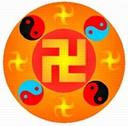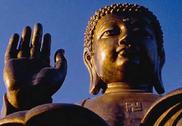The Epoch Times
Sep 04, 2004
 |
| Falun Gong Symbol containing swatiska symbol |
Beginning in October 1999, the German police confiscated banners or posters displaying the Falun Gong emblem, as it contains a swastika that resembles the Nazi swastika, although it is different in Colo and points in a different direction. In Autumn 2002, the German Falun Dafa Association received a felony notice from the Mannheim District Court for displaying the Falun emblem on its website. In May 2003 an indictment notice arrived from the District Court with a one week right to appeal. The group retained an attorney and consulted renowned German Sinologist, Professor Rudolf G. Wagner of the University of Heidelberg. In November 2003, the court rendered a verdict of "not guilty" and declared the display of the Falun emblem as legal under German law. The public prosecutor lodged an appeal, but in March 2004 the original judgement was upheld. The Falun symbol can now be legally displayed on the Falun Gong website in Germany, as it is in other countries around the world.
 |
| Ancient statues of Buddhas often show a swastika on the chest or forehead |
The word swastika originated from Sanskrit, an ancient Indian language. There are a number of interpretations. A literal translation of the Sanskrit word is, "being fortunate," or if one divides the word into two parts, "Su" means good/well, and "astika" means being. Other names for the swastika are, "Hakenkreuz" by Nazi Germany, "Fylfot" by the Saxons, "Crux Gammata" in Latin, "Tetraskelion or Gammadion" in Greece and "Om" by the people from India. In China, this symbol is called "Wan" (Mandarin Chinese), connoting happiness.
Surprisingly, swastika symbols may not all be in the same form. Some may point in different directions, for instance clockwise (found in monasteries in the north west of Nepal on the Tibetan Plateau) and counter-clockwise (in Buddhist monasteries). Both varieties were found in a single tomb in Aladja-Hoyuk, Turkey. Some might be more intricate or more artistically designed than others, but the fundamental form is always retained.
 |
| In the past, postcards such as this were exchanged to pass on "good luck" to a friend |
Hitler's use of the swastika symbol had made it a pariah worldwide. Rudyard Kipling (author of The Jungle Book) removed it from his books after 1935. Before the late 1930's it was displayed on coins, bridges and postcards worldwide. Coca Cola used it in its advertisements (1925). Postcards with the symbol could be found for sale in the United States.
The March 2004 verdict by the Mannheim Court is significant, coming from a court system in the country where the swastika was defiled. The court found a clear distinction between Hitler's swastika and the Falun Gong symbol.
The Jewish Virtual Library, an American-Israeli Enterprise, has also addressed the history of the Swastika positively.
Source: http://english.epochtimes.com/news/4-9-4/23097.html
* * *
You are welcome to print and circulate all articles published on Clearharmony and their content, but please quote the source.










 more ...
more ...